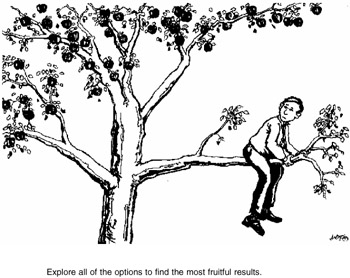The Keys to Step 4
The Keys to Step #4
Identify Options with an Open Mind
The way you bring alternatives to the surface makes a big difference in the possibilities you come up with. All too often, participants in a group or meeting focus on advocating their own ideas, attacking others' ideas, or withholding potential solutions to avoid the fray. Such fear-based responses stifle the possibility of discovering creative solutions to the problem at hand.
If the only tool you have is a hammer, you tend to see every problem as a nail.
—Abraham Maslow
In order to shift to a positive, hopeful approach and get the best results from the decision-making process, participants must keep their egos free from attachment to particular options and remain open to new possibilities. They need to feel free to shift their stance from position advocacy to idea generation without fear of others judging their ideas prematurely.
Use Catalysts to Precipitate New Ideas
People learn and explore ideas in multiple ways. In addition to visual sources (such as schematics and instruction books), auditory means (such as hearing the sound of a machine part or listening to others' ideas) and physical movement (such as acting out a scenario) can yield valuable insights and potential solutions. Explore all three modes to increase the likelihood of finding innovative solutions to your problems.
One of the stimuli for the turbine plant team's creative ideas came from an unconventional approach. Since no one could see inside the turbine rotor assembly, and the diagrams offered an abstract view, volunteers used their bodies to act out what they thought the units were doing when the breakdowns occurred. They lined up in the conference room, with different people taking different positions, and simulated how the long, complex chain of pieces moved and changed under different conditions. This kinesthetic enactment helped the group apprehend the problem in a fresh way and identify several new ideas.
People have many more ideas and possibilities in their heads than they typically consider. Often, the pieces are there, and they simply need a catalyst for new solutions to form. Use trigger concepts or metaphors to precipitate inventive approaches. The bibliography at the back of this book identifies several resources to stimulate new ideas.
Look at the Whole Tree to Get Fruitful Results
Think of your problem as a tree with many branches. Look at the whole tree and all the branches you could follow before you go out on a particular limb. (See Figure 10.) You'll get more fruitful results more quickly.

Figure 10: See the whole tree before you go out on a limb.
Turn Challenges into Opportunities
After a team penetrates to the bedrock of its hopes, it can tap a broad array of potential solutions. Liberated from preconceived avenues to realizing their hopes, team members can explore new options. When they have many choices, participants in a decision-making group don't feel trapped or forced into a particular course of action. Having choices unleashes new energy.
EAN: 2147483647
Pages: 112